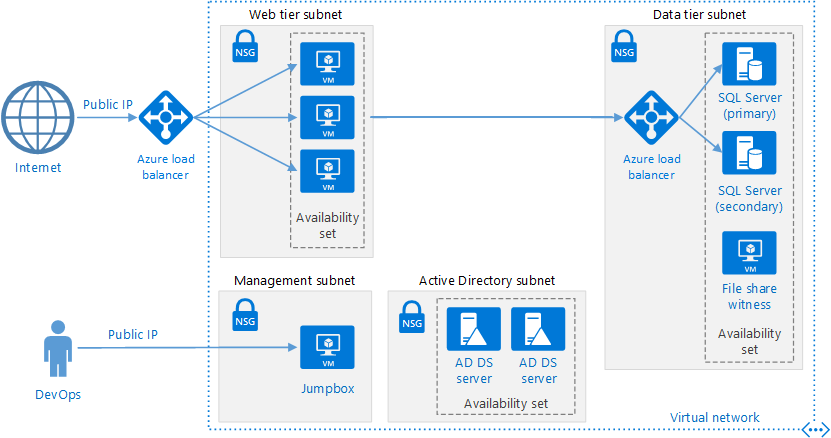This Azure Blueprint solution automatically deploys a multi-tier web application architecture with pre-configured security controls to help customers achieve compliance with FedRAMP requirements. The solution consists of Azure Resource Manager (ARM) templates and PowerShell scripts that guide resource deployment and configuration. An accompanying Blueprint compliance matrix is provided, showing security control inheritance from Azure and where deployed resources and configurations align with NIST SP 800-53 security controls, thereby enabling organizations to fast-track compliance obligations.
This solution deploys a notional architecture for a web application with a database backend. The architecture includes a web tier, data tier, Active Directory infrastructure, application gateway and load balancer. Virtual machines deployed to the web and data tiers are configured in an availability set and SQL Servers are configured in an Always On availability group for high availability. A management jumpbox (bastion host) provides a secure connection for administrators to access deployed resources. [AIS to supplement]
The architecture includes the following Azure products:
- Virtual Machines
- Virtual Network
- Load Balancer
- Application Gateway
- Storage
- Backup
- Key Vault
- Azure Active Directory
- Azure Resource Manager
- Application Insights
- Log Analytics
- Automation
- Scheduler
- Operations Management Suite
During pre-deployment you will confirm that your Azure subscription and local workstation are prepared to deploy the solution. The final pre-deployment step will run a PowerShell script that verifies setup requirements, gathers parameters and credentials, and creates resources in Azure to prepare for deployment.
This Azure Blueprint solution is designed to deploy to Azure Government regions. The solution does not currently support Azure commercial regions. Customers must have a paid Azure Government subscription or sponsored account to deploy this solution. [need to confirm]
The Azure Active Directory administrator with global privileges is required to deploy this solution. [need to confirm]
[Are there any other steps that need to occur within the subscription to be able to deploy?]
PowerShell is used to initiate pre-deployment, deployment, and post-deployment tasks. PowerShell version [X.X] or greater must be installed on your local workstation. In PowerShell, you can use the following command to check the version:
$PSVerstionTable.psversion
The PowerShell pre-deployment task includes installation of Azure PowerShell modules, so PowerShell must be run in administrator mode.
The pre-deployment PowerShell script will verify that a supported version of PowerShell is installed, that the necessary Azure PowerShell modules are installed. Azure PowerShell modules provide cmdlets for managing Azure resources. After all setup requirements are verified, the script will prompt for parameters and credentials to use when the solution is deployed. The script will prompt for the following parameters:
[For any other parameters that the customer needs to look up (e.g., subscription ID), provide instructions to find]
-
subscriptionID: To find your Azure Government subscription ID, navigate to https://portal.azure.us and sign in. Expand the service menu, and begin typing "subscription" in the filter box. Click on Subscriptions to open the subscriptions blade. Note the subscription ID, which has the format xxxxxxxx-xxxx-xxxx-xxxx-xxxxxxxxxxxx.
-
resourceGroupName: The resource group name must be a string of 1-90 alphanumeric characters (0-9, a-z, A-Z), periods, underscores, hyphens, and parenthesis and cannot end in a period (e.g.,
blueprint-rg). -
keyVaultName: The Key Vault name must be a string 3-24 alphanumeric characters (0-9, a-z, A-Z) and hyphens and must be unique across Azure Government.
-
adminPassword: Administrator password for local VM accounts (must complexity requirements)
-
sqlServerServiceAccountPassword: SQL service account password (must complexity requirements)
- Clone this GitHub repository to your local workstation
git clone https://github.com/[to be updated]/blueprint.git C:\blueprint
- Start PowerShell as an administrator
- Run Orchestration_InitialSetup.ps1
- Enter the parameters above when prompted
During this phase, an Azure Resource Manger (ARM) template will deploy Azure resources to your subscription and perform configuration activities.
[Description of how the deployment works, ARM, PowerShell scripts used...]
After clicking the Deploy to Azure Gov button, the Azure portal will open and prompt for the following settings:
[For settings that the customer needs to look up (e.g., subscription ID), provide instructions to find]
-
Key Vault Name: Name of the Key Vault created during pre-deployment
-
Key Vault Resource Gorup Name: Name of the resource group created during pre-deployment (e.g., blueprint-rg)
-
Admin Username: User account name for local VM administrator accounts
- Click
- Enter the settings above
- Review the terms and conditions, then click I agree to the terms and conditions stated above.
- Click Purchase.
This solution uses multiple nested templates to deploy and configure the resources shown in the architecture diagram. The full deployment will take approximately [xx] minutes. You can monitor the deployment from the Azure portal.
[instructions / screen captures]
The full timeline for the deployment is shown below.
[deployment timeline]
Post-deployment tasks include [...]
[Instructions to access VMs]
[Instructions to view OMS dashboard(s)]
Deploying this solution will create resources within your Azure subscription. You will be responsible for the costs associated with these resources, so it is important that you review the applicable pricing and legal terms associated with all resources and offerings deployed as part of this solution. For cost estimates, you can use the Azure Pricing Calculator.
[Estimated monthly cost of deployed resources]
[TBD]
If your deployment should fail, to avoid incurring costs and orphan resources it is advisable to delete the resource group associated with this solution in its entirety, fix the issue, and redeploy the solution. See the section below for instructions to delete all resources deployed by the solution.
[Common problems; where to obtain support, etc.]
TBD
